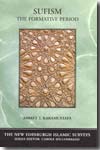Sufism
the formative period
- ISBN: 9780748619191
- Editorial: Edinburgh University Press
- Fecha de la edición: 2007
- Lugar de la edición: Edinburgh. Reino Unido
- Colección: The New Edinburgh Islamic Surveys
- Encuadernación: Rústica
- Medidas: 24 cm
- Nº Pág.: 202
- Idiomas: Inglés

This book offers a comprehensive survey of the formative period of Sufism - the main mystical tradition in Islam - from the ninth to the eleventh century. Both the literature in the area and issues and questions that await further study are explored within an interpretive framework. The major themes of the book include the following: growing out of traditionalist approaches to Islam during the ninth century, Sufism originally took shape in Iraq, especially Baghdad, and rapidly spread to other regions of the Islamic world. There were mystical trends outside Iraq, but they gradually blended into Sufism; early Sufis attempted to turn away from everything 'other-than-God' and orient themselves solely towards the Divine, but this attempt took multiple forms. The themes of the book also include: communities of Sufis organized around particular Sufi masters began to appear in the tenth century and had become a prominent feature of Islamic societies by the eleventh century; even though tendencies toward standardization and systematization appeared early in Sufi history, major Sufi figures maintained a critical attitude towards legalism and formalism of any kind and considered Sufism to be the core of Islam; early Sufis generally showed little interest in legal, theological, philosophical and 'occult' discourses, but from the mid-eleventh century onwards proceeded to incorporate these approaches into Sufism; and at around the same time, Sufis increasingly began to gain popularity as 'saints' and soon popular cults grew around major Sufis in both urban and rural environments. This growing popularity brought Sufis into the orbit of political power. It strikes a balance between social and intellectual history. It identifies and articulates questions of interest to scholars, students and general readers, and places Sufism within its broader cultural context.






